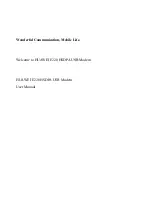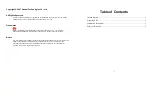
DMD15/DMD15L IBS/IDR Satellite Modem
Operation
TM051 - Rev. 5.8
3-13
3.14 Loop Timing
If loop timing is desired (i.e.; the modem timing is slaved to the far end master station), the
modem clocks can be configured as follows:
3.14.1 Transmit (RS-422 or V.35 Interface)
Set SCT Source to ‘SCR’. The Tx Terminal Equipment must clock the TX Data with the SCT
Clock and return data and SCTE (Optional). If SCTE is returned to the modem from the terminal
equipment, set TX CLK to SCTE. If SCTE is not returned to the modem, set TX CLK to SCT.
The TX CLK PHASE should be set to AUTO.
3.14.2 G.703 Interface or Asymmetrical Data Rates
Loop timing with a G.703 Interface or Asymmetrical Data Rates requires external equipment at
the remote end that is capable of using the recovered RD Clock as source timing for (SCTE) SD.
The modem will not manipulate the clock frequency. Therefore, the transmit and receive clock
rates must be equal in order for the modem to perform loop timing.
3.14.3 Receive
Select the Buffer clock to RxSAT (SCR).
3.15 Drop and Insert (D&I)
The Radyne DMD15/DMD15L Drop and Insert (D&I) Function provides an interface between a full
T1 or E1 Trunk whose framing is specified in CCITT G.704 and a fractional Nx64 Kbps Satellite
Channel that conforms to the IBS and small IDR Framing Structures. The Drop function allows
the user to select the terrestrial T1 or E1 timeslots that are to be dropped off for transmission over
the link in the specified satellite channels.
The Insert function allows the user to select the T1 or E1 timeslots into which the received satellite
channels are to be inserted. The two functions are completely independent allowing maximum
flexibility in choosing configurations. The four-port G.703 Interface allows one or more modems to
be looped together using the same T1 or E1 trunk.
The Transmit Data Trunk is brought into the modem via the Send Data In (SDI) Port. From there,
the TX Baseband Processor extracts the selected timeslots from the G.704 Frame and prepares
them for transmission. The original trunk data is sent out of the modem unaltered via the Send
Data Out (SDO) Port. The Receive Data Trunk is brought into the modem via the Insert Data In
(IDI) Port. The data is buffered inside the modem and the RX Baseband Processor inserts
satellite data into the selected timeslots in the G.704 Frame. The modified terrestrial trunk is then
output via the Receive Data Out (RDO) Port.
Figure 3-8 shows two modems looped together. This configuration could be simplified to just use
one modem, or extended to use more than two modems. Figure 3-9 shows an alternative method
of looping where all of the drop (transmit) data is processed prior to performing any insert
(receive) processing. In both configurations, the terrestrial trunk is providing the timing for the
satellite transmission and for the terrestrial receive.
Содержание DMD15
Страница 2: ......
Страница 7: ...DMD15 DMD15L IBS IDR Satellite Modem TM051 Rev 5 8 vi...
Страница 17: ......
Страница 27: ...Operation DMD15 DMD15L IBS IDR Satellite Modem 3 6 TM051 Rev 5 8 Figure 3 4 Loopback Functional Block Diagram...
Страница 50: ...DMD15 DMD15L IBS IDR Satellite Modem Operation TM051 Rev 5 8 3 29...
Страница 51: ......
Страница 167: ...User Interfaces DMD15 DMD15L IBS IDR Satellite Modem 5 14 TM051 Rev 5 8...
Страница 181: ...Technical Specifications DMD15 DMD15L DMD15 DMD15LL DMD15 DMD15LIBS IDR Satellite Modem 7 8 TM051 Rev 5 8...
Страница 182: ...DMD15 DMD15L DMD15 DMD15LL DMD15 DMD15LIBS IDR Satellite Modem Technical Specifications TM051 Rev 5 8 7 9...
Страница 183: ...Technical Specifications DMD15 DMD15L DMD15 DMD15LL DMD15 DMD15LIBS IDR Satellite Modem 7 10 TM051 Rev 5 8...
Страница 194: ...DMD15 DMD15L DMD15 DMD15LL DMD15 DMD15LIBS IDR Satellite Modem Glossary TM051 Rev 5 8 5 11...
Страница 195: ......
















































